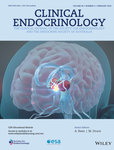Area under the curve during OGTT in first-degree relatives of diabetic patients as an efficient indicator of future risk of type 2 diabetes and prediabetes
Authors
Affiliations
Abstract
Objective: To establish whether the area under the curve of an OGTT has a predictive role in identifying prediabetic and diabetic subjects among first-degree relatives (FDR) of patients with diabetes mellitus type 2 (DM).
Design, patients and measurements: In a population-based cohort study, 766 FDR of diabetic patients with a normal glucose tolerance test (NGT) completed a 2-hour OGTT. They were followed up for 7 years and classified according to the American Diabetes Association criteria into: NGT, impaired fasting glucose (IFG), impaired glucose tolerance (IGT) and DM. Relative risk (RR) and 95% confidence intervals (95%CI) were calculated based on logistic regression. Receiver operator characteristic (ROC) analysis along with AUC at different intervals and at time points during the OGTT was used to evaluate the risk of prediabetes and diabetes.
Results: Twenty-three subjects (3%) developed type 2 DM, 118 (29.3%) IFG, 81 (11.5%) IGT and 544 (71%) subjects remained NGT. AUC and mean difference of glucose in all high-risk groups demonstrated significant differences in both intervals and time points when compared to the NGT group. The cut-off values during OGTT to predict prediabetes and diabetes was determined as blood glucose more than 7.2 and 7.8 mmol/L at 30 and 60 minutes, respectively. The time point 60 has the highest predictive role for the development of diabetes, alone, and improved the performance of a prediction model containing multiple important clinical risk factors.
Conclusion: The data suggest that the glycaemic response to an OGTT may predict the risk of development of diabetes in first-degree relatives of DM patients.
Keywords: diabetes mellitus; first-degree relatives; oral glucose tolerance test; pre-diabetes.

